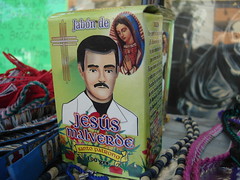
The Legend of Jesus Malverde, Patron 'Saint' of Narco Traffickers, Grows in Mexico
David Agren | Bio | 28 Jun 2007
World Politics Review Exclusive
MEXICO CITY -- Alejandro Ruiz Rodriguez, a Mexico City law student, lost a stack of important legal documents last year. Despite searching everywhere imaginable, they never turned up. As a last resort, he asked Jesus Malverde, an unofficial saint beloved by narcotics traffickers, for intervention. Inexplicably, the documents surfaced shortly thereafter.
"I don't know if it was just by chance or if Jesus Malverde was responsible," the 26-year-old said at a monthly gathering of Malverde adherents in Mexico City.
"Either way, I'm here every month to give thanks . . . it was absolutely miraculous."
Like an increasing number of Mexicans, Ruiz believes in the legend of Jesus Malverde, a mustachioed bandit from the hills of Sinaloa state that, like Robin Hood, reputedly stole from the rich and gave to the poor until his death by hanging in 1909. Narcotics traffickers claim him as their own and donate heavily to maintain a shrine in Culiacan, the capital of Sinaloa, a western state notorious for smuggling activities and home to a powerful drug cartel of the same name. Even with narcotics-cartel violence flaring across Mexico, Malverde's legend is growing and seeping into the broader popular culture. In addition to the Culiacan shrine, a smaller shrine was recently built on a sidewalk in Mexico City's tough Doctores neighborhood. A martini bar in the capital's chic Condesa district adopted the narco saint's name and a piece inspired by Malverde recently won acclaim at a major art fair.
In Doctores, Maria Alicia Pulida Sanchez, who makes a modest living by running a mom-and-pop store, erected the Malverde shrine after her teenage son recovered from an automobile accident more quickly than expected -- something she credited to her praying to the unofficial saint, who she insisted "wasn't a narco.
"He was a thief, but at the same time, he was a thief who helped his community," she said.
Like Robin Hood, "He was a thief who would steal from the rich and give to the poor."
As dusk fell on a quiet Sunday in Mexico City's Colonia Doctores, a group of men in blue jeans loaded a life-size statue of Jesus Malverde along with a similar statue of San Judas, the patron saint of lost causes, into the bed of a Ford pickup truck for a spin around the neighborhood. On the third day of every month, some 30 to 70 adherents gather at the sidewalk shrine to pay homage to the bandit-turned-unofficial saint, whom they attribute miracles to and in many cases ask for intervention.
A similar scene is carried out in Culiacan on a regular basis at the Jesus Malverde shrine, which stands near the state legislature and a McDonald's restaurant and appears on maps distributed by the municipal tourism board. On May 3, the supposed anniversary of Malverde's death, the shrine throws a party complete with banda groups playing narcocorridos -- songs glorifying narcotics traffickers -- and despensas (giveaways) of food, household items and toys. Throughout the year, the shrine reportedly funds charity projects -- like paying funeral expenses for those lacking money. According to some of the shrine's visitors, narco donations underwrite almost everything.
"Narcos pretty much sponsor this place," said Alfredo Aguilar, a sugar cane farmer from rural Sinaloa.
Like many at the shrine, he insisted Malverde was for all people -- not just narcos.
"All sorts of people come here . . . famous people, important people, poor people, rich people," said Doña Tere, an elderly woman, hawking Malverde busts at the shrine.
Visitors to the Malverde shrine often leave Polaroid photos with pithy notes. Wealthier visitors, including some from the United States, sometimes pay for permanent plaques, which usually give thanks for "favors received" and "success in business."
Drawing on Malverde's notoriety is now becoming a good business for entrepreneurs beyond Sinaloa. The Malverde Bar in Mexico City attracts the fresa crowd (young monied set) with $7 martinis and an ambiance drawn from the tacky side of Mexican pop culture. Bartender Luis Mondragon insisted, "This place isn't about glorifying narcos."
Beyond the trend of Mexican youth indulging the naco (low class) side of their pop culture, researcher Arturo Navarro Ramos of the ITESO university in Guadalajara described most of Malverde's followers as marginalized people.
"He makes it possible to live life on the margins," he said, pointing to narcotics traffickers as prime examples.
"Malverde facilitates the view that people can be saved while not giving up their improper activities."
Due to the sketchy accounts of Malverde's life -- even details of his death are disputed -- Navarro figured Malverde would never be recognized as an official saint by the Catholic Church, which only in the past few years promised to start better scrutinizing the sources of large donations that may or may not be coming from narcotics traffickers.
Regardless of Malverde's shady reputation, law student Alejandro Ruiz Rodriguez, who insists he'd never engage in illegal activities, said he would be returning to the Doctores shrine every month.
"It's pure faith," he commented.


No comments:
Post a Comment